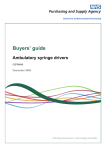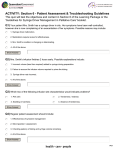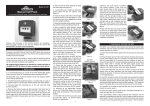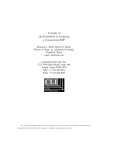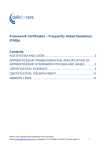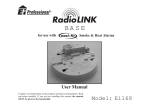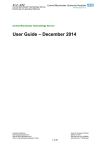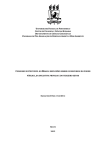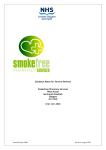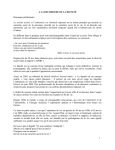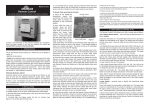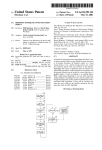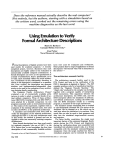Download Guidelines. - palliativecareggc.scot.nhs.uk
Transcript
McKinley T34 Syringe Pump Guidelines for use in Adult Palliative Care Patients Guideline for use in Greater Glasgow areas NHS Greater Glasgow Palliative Care Teams This guideline should be used in conjunction with your area’s Guidelines for the use of Subcutaneous Medications in Palliative Care. January 2009 Review by January 2011 2 Contents Introduction....................................................................................................................... 5 Section 1 - Guidelines Definition of Syringe Pumps.............................................................................................. 8 Background....................................................................................................................... 8 Safety: Risk Management ............................................................................................................. 8 Syringe Pump Maintenance................................................................................................ 8 Cleansing and Decontamination........................................................................................ 9 Incident Reporting.............................................................................................................. 9 Hazard Warning Notification.............................................................................................. 9 Training............................................................................................................................. 9 Section 2 - Setting up syringe pump Choice of Syringe............................................................................................................ 12 Requirements.................................................................................................................. 12 Procedure: Step 1- Filling the syringe ................................................................................................13 Step 2 - Labelling.............................................................................................................16 Step 3 - Prepare the McKinley T34 Syringe Pump..............................................................16 Step 4 - Connecting the infusion set to the syringe............................................................17 Step 5 - Fitting the syringe to the syringe pump................................................................ 18 Step 6 - Starting the infusion (new patient)...................................................................... 19 Step 7 - Keypad lock......................................................................................................... 20 Step 8 - Lockboxes........................................................................................................... 21 Step 9 - Documentation and monitoring........................................................................... 21 Step 10 - How to temporarily stop the infusion................................................................. 23 Step 11 - How to stop the infusion and prime a new line after the infusion has started...... 24 Step 12 - What to do if the Saf-T-Intima cannula needs to be resited (if using an extension line)............................................................................................... 24 Step 13 - How to change the battery when an infusion pump is running........................... 24 Step 14 - Stopping the infusion and removing the syringe pump....................................... 25 Step 15 - What to do if the patient dies when the syringe pump is running....................... 25 Continues overleaf 3 Section 3 – Syringe pump problem solving Common Problems - table............................................................................................... 28 Clinical Scenarios/Problem Solving - table........................................................................ 28 Other Problems - Pump running fast.................................................................................................... 29 - Pump running slow.................................................................................................. 29 - Site irritation............................................................................................................. 29 - Precipitation/cloudiness/colour change.................................................................... 30 Breakthrough Symptoms................................................................................................. 30 Care during infusion........................................................................................................ 30 McKinley T34 Pump Alarm Conditions............................................................................. 31 Abbreviations used.......................................................................................................... 32 References....................................................................................................................... 32 Acknowledgements......................................................................................................... 33 Contributors.................................................................................................................... 33 Appendix 1 - ‘Using the McKinley T34 Syringe Pump’- flowchart..................................... 34 4 Introduction This guideline was produced to assist professionals administering drugs via an ambulatory syringe pump and to promote a procedural uniformity amongst those professionals, be it in the hospital, hospice or community setting. This document is in response to changes in national policy and practice and development within the palliative care speciality. In line with the Medicines & Healthcare Regulatory Agency (MHRA) requirements for infusion devices, the Health Board area has changed to the McKinley T34 Syringe Pump from July 2007. This process will be in a phased manner and once the McKinley T34 has been introduced in each area, all Graseby MS26 and MS16a syringe drivers will become obsolete and be withdrawn from use. 5 6 Use of McKinley T34 Syringe Pump in Adult Palliative Care Patients Section 1 – Guidelines Section 1 Guidelines 7 Use of McKinley T34 Syringe Pump in Adult Palliative Care Patients Section 1 – Guidelines Syringe Pumps Definition A McKinley T34 syringe pump is a portable battery-operated infusion pump weighing approximately 210g. (excluding the battery) and measuring 169mm by 53mm by 23mm. Background The syringe driver was developed in 1979 by Dr. Martin Wright for use in treating thalassaemia with infusions of Desferrioxamine (Wright & Callan, 1979). The use of a portable battery operated syringe driver for subcutaneous medications is now a well established technique in palliative care; this view is supported by Dickman et al 2005, who suggests “that it is particularly suited to palliative care”. The syringe driver, (Hunt 2002) “allows for a minimally invasive route of drug administration, which produces relatively constant levels of medication which avoids peaks, which can result in reduced symptom control” (Hunt 2002). Palliative care patients often present with multiple symptoms that can necessitate the need to use several drug treatments. If the patient’s condition deteriorates and the oral route cannot be used Dickman 2005 further suggests, “That a continuous subcutaneous infusion via the syringe driver provides a simple and effective way to control symptoms”. The McKinley T34 Syringe Pump is a more advanced delivery system than a syringe driver and is a typical example of ambulatory syringe pumps; however, other types are available and professionals should follow the manufacturer’s instruction manual for details of their use. Safety Risk Management Parenteral administration of medicines carries a number of risks which have been well documented. Syringe pumps may be used infrequently and competency can be difficult to maintain where use is infrequent. The Scottish Executive Health Department publication provides guidance on the principles to minimise these risks (CRAG/NHS Scotland 2002). The provision of local guidance on the use of syringe pumps builds on this process to enable dissemination of consistent advice and best practice. Syringe Pump Maintenance All syringe pumps are serviced regularly by the local Medical Physics Department according to a defined schedule and at least annually, whether used or not. Syringe pumps should be sent for maintenance checks if they have been dropped or submerged in fluid or if there is any doubt as to their handling operation whilst in use. Information on requirements is available from your local Medical Physics Department. A register of all such devices within the health board area is maintained by the Medical Physics Department and they must be notified, according to procedure, of any new syringe pumps or if any syringe pumps have been removed from services. 8 Use of McKinley T34 Syringe Pump in Adult Palliative Care Patients Section 1 – Guidelines Cleansing and Decontamination Cleansing should be carried out with a damp disposable cloth (use warm water and generalpurpose detergent). Dry thoroughly. If any additional cleansing is needed, e.g. the threads of the screws the actuator moves along, contact infection control team for advice. The pump must not be submerged in water (and if it is accidentally dropped in water, it must be withdrawn from use immediately and sent to Medical Physics). Do not use chemicals such as Xylene, acetone/similar solvents or Cliniwipes (or similar) as this will cause damage to components and labels. Incident Reporting Systems are in place within NHS Greater Glasgow and Clyde to monitor and report incidents involving syringe pumps and staff should be familiar with the relevant incident reporting system and relevant documentation (Adverse Clinical Incident Form or IR1 in hospitals and primary care; local systems for hospices. Incidents should be reported via the Datix system where appropriate as it is rolled out throughout the health board). NHS Greater Glasgow and Clyde Incident Management policy can be accessed via StaffNet in the Clinical Governance section. All incidents will be investigated. Audit of this information, along with audit against the standards for use of syringe pumps assists in identifying training needs. What defines an incident? • • Administration of incorrect medication, dose and/or diluent selection. • • Device not alarming. Infusions completing ahead of intended time or carrying on beyond intended time of completion. Any other incident or near miss which may compromise patient safety or comfort. N.B. Any device and consumable involved in an adverse incident should be “quarantined” and sent to Medical Physics. Who can report incidents? • Any member of staff can and has a professional responsibility to report an incident to their line manager and complete an incident report form. Hazard Warning Notification NHS Greater Glasgow and Clyde operates a cascade system for hazard warning notification. Individuals with responsibility for managing areas where syringe pumps are in use must ensure relevant notices are acted and reported upon. Training All staff using a syringe pump must be personally competent and accountable in the use and operation of such devices. Managers should ensure that relevant training takes place (e.g. at induction) and maintain a record of staff who are trained and competent to use such devices. (The Management of Infusion Systems SEHD). 9 Use of McKinley T34 Syringe Pump in Adult Palliative Care Patients Section 1 – Guidelines Qualifications required Registered nurses – currently registered with the NMC. 1st level nurse can prepare, administer and refill syringe pump. 2nd level nurses can monitor an infusion (under review July 2008). Additional requirements Has undergone training on syringe pump management for patients requiring palliative care. Continuing training requirements Request supervised practice by informing manager when training is required. It is the responsibility of the individual registered nurse to ensure they keep up to date with this aspect of care. Competencies in the use of Syringe Pumps are available on the Skills for Health website: www.skillsforhealth.org.uk N.B. There is also a patient information leaflet on syringe pumps. Refer to Palliative Care Guidelines folder if available in clinical area. Alternatively, download from: www.palliativecareggc.org.uk 10 Use of McKinley T34 Syringe Pump in Adult Palliative Care Patients Section 2 – Setting up the Syringe Pump Section 2 Setting up the Syringe Pump 11 Use of McKinley T34 Syringe Pump in Adult Palliative Care Patients Section 2 – Setting up the Syringe Pump The McKinley T34 Syringe Pump The McKinley T34 model is calibrated in ml per hour. All T34 pumps for palliative care are set up to deliver the syringe contents by continuous subcutaneous infusion over a 24 hour period only. Staff must not borrow pumps from other areas and must check that the display shows ‘Pall Care 24Hr’ when switched on. Choice of Syringe The McKinley T34 pump may be used with most makes of syringes. The most commonly used syringes have been 10ml and 20ml, however it has been more recently advocated (Dickman 2005) that a 20ml syringe is the recommended minimum for several reasons: a larger dilution will reduce both the risks of adverse site reactions and incompatibility and it also accommodates large doses of drugs. It is therefore recommended that 20ml and 30ml syringes should be used and that they MUST have a luer lock facility in order to avoid leakage or accidental disconnection. The recommended make of syringe is Becton Dickinson (BD) and the pumps will be set to recognise this manufacturer only. Seek advice from Medical Physics if you do not have access to BD luer lock syringes. N.B. The 50ml luer lock syringe is the largest syringe that will fit the McKinley T34 syringe pump. It allows drugs to be diluted up to approximately 34mls volume for BD syringes. This reduces the need for a second syringe pump when giving larger volume drugs, e.g. metoclopramide. A 50ml syringe is not recommended for routine use (it will not fit into the standard lockbox) but may be used for specific problem infusions. Size of BD syringe Maximum fill volume as stated in user manual Suggested fill volume (if not priming line)* 20ml syringe 18ml 17ml 30ml syringe 23.5ml 22ml 34.9ml 34ml 50ml syringe (exceptional circumstances) *If priming line, then add on priming volume to these figures Reference: McKinley T34 Ambulatory Syringe Pump Operation Manual, March 2006 Requirements • McKinley T34 syringe pump. • Battery, PP3: 9 volt alkaline/lithium. Plus spare battery as a new battery will last for approximately 3-4 days depending on use. • • 20ml or 30ml luer lock BD syringe. Saf-T-Intima cannula 22G (Supplies order code L003052) and 100cm extension set with integrated anti-siphon valve (McKinley 100-172S, Supplies order code L004553) and a Bionector (Supplies order code L000527). Some clinical areas are currently trialling the use of Saf-T-Intima with the McKinley extension set. This will be rolled out if successful and therefore is referred to throughout this document. The Saf-T-Intima is the recommended cannula for subcutaneous use in palliative care patients. 12 Use of McKinley T34 Syringe Pump in Adult Palliative Care Patients Section 2 – Setting up the Syringe Pump • Ensure skin is clean. Wash with soap and water if visibly soiled. • Transparent adhesive dressing e.g. TEGADERM • Prescribed medicines / diluent • Syringe pump prescription / recording sheet / infusion label • Patient’s own electric razor or scissors (for hair removal if necessary) • Holster (only if patient is mobile), lockbox and key Procedure Step 1 – Filling the syringe • • Use a luer lock syringe of at least 20ml. It may not be possible to fill all sizes of syringe to full capacity (see table on page 12). Practice Point: Check that the syringe you have selected will fit securely in the pump. Practice Point: Calculate the volume of the drug that needs to be drawn up from the concentration of the preparation you have and the prescribed dose (unless the drug comes in a powder formulation, do not count the number of ampoules as a final check, use the volume. Ampoules have an overage from the volume stated on the label and although there is a regulation minimum, there is no maximum) For one drug in the pump • • Select appropriate syringe size. Draw up the prescribed medication, and then add diluent (usually water for injection for combinations of 2 or more drugs as less chance of precipitation but refer to compatibility charts) to appropriate volume, draw up a little air into the syringe, invert it gently several times to mix, and then expel the air. (Take care not to expel any of the medication.) Note: If the drug is only available in a powdered form and the dose is less than the full amount in the ampoule, you will need to measure accurately the amount of water used for reconstitution, and calculate the volume of solution to be taken out to give the required dose. Example 1 If you add 0.5ml of water to a 100mg amp of diamorphine, and then make the solution up to 1.0ml, you will have a solution containing 100mg/ml diamorphine. If only 80mg is required, then 0.8ml should be drawn up in the syringe and the remainder discarded. One method of calculating this is: Volume required (ml) = what you want (dose in mg) ÷ what you’ve got (dose in mg) x volume you’ve got (ml), i.e. volume required = 80mg ÷ 100mg x1.0ml=0.8ml. Continues overleaf 13 Use of McKinley T34 Syringe Pump in Adult Palliative Care Patients Section 2 – Setting up the Syringe Pump Example 2 Once you have dissolved the diamorphine, make the volume up to a figure which makes it easy to calculate the volume to withdraw. If you wanted 20mg from a 30mg ampoule, it would be difficult to do this with 1.0ml as you need 2/3rds of this. If you make the solution up to 3.0ml, the calculation is easy. i.e. volume required = 20mg ÷ 30mg x 3.0ml = 2ml The same calculation applies to other drugs, but make sure you use consistent units (e.g. mg or micrograms) throughout the calculation. Example 3 A dose of 5mg of levomepromazine has been prescribed. The ampoules are 25mg in 1ml. You need to calculate the volume of the injection to measure. Using the same formula as Example 1: Volume required (ml) = what you want (dose in mg) ÷ what you’ve got (dose in mg) x volume you’ve got (ml), i.e. volume required = 5mg ÷ 25mg x 1.0ml = 0.2ml Example 4 Metoclopramide 60mg by subcutaneous infusion has been prescribed. The ampoules contain 10mg in 2ml. Volume required (ml) = what you want (dose in mg) ÷ what you’ve got (dose in mg) x volume you’ve got (ml) i.e. volume required = 60mg ÷ 10mg x 2.0ml = 12ml You can use the same formula for doses in micrograms, but ensure you use micrograms for both what you want, and what you’ve got. Mixing drugs in the syringe pump There are various problems associated with the mixing of drugs. These include: • Degradation of the drug(s) which in turn can lead to decreased efficacy. The rate of degradation may be increased by other drugs which alter the pH of the mixture. Direct sunlight and heat can also cause degradation of the drugs. • Crystallisation/precipitation. This can occur through formation of an insoluble product of drug interaction, or because a drug alters the pH of the solution rendering a second drug insoluble, or because of an interaction between drug and diluent. Points to remember: • Check compatibility charts (see ‘Guidelines for the Use of Subcutaneous Medications in Palliative Care’). • Consider factors affecting choice of final volume (drug concentration and hence stability and irritation at site). 14 Use of McKinley T34 Syringe Pump in Adult Palliative Care Patients Section 2 – Setting up the Syringe Pump • • • Consider using an additional pump or an alternative route of drug administration. Inspect the mixture at the start and at the agreed monitoring frequency. Monitor the patient for any signs of decreased efficacy. For two drugs in the pump Check compatibility charts! • Calculate the volume for each prescribed drug, establish final volume required and select appropriate size of syringe. • Reconstitute diamorphine (if prescribed) and draw into luer lock syringe. Then, dilute to an appropriate volume (total volume less volume of second drug). If neither of drugs is diamorphine, follow same procedure with alternative opioid, if prescribed, or otherwise with one of prescribed drugs. • Draw up the second drug into a separate syringe of appropriate size and leave needle attached. • Pull back plunger on first syringe to beyond final intended volume, and add second drug carefully through the luer end. • Invert the syringe gently several times to mix the 2 drugs (there needs to be a little air in the syringe for this to be effective), then carefully expel the air, taking care not to expel any of the drug mixture. For three drugs in the pump Check compatibility charts! • This should be attempted only when evidence of stability exists (chemical, physical or observational), or on the advice of a palliative care specialist when other options, e.g. a second syringe pump, are not available or patient is cachectic with few available sites. • Proceed in a similar manner to above, diluting 2 of the drugs as far as possible before adding the third. If dexamethasone or cyclizine are included in the mixture, add them last once the other 2 drugs are diluted as far as possible (because they are the commonest causes of incompatibility). Dexamethasone is usually given as a once or twice daily subcutaneous bolus injection to avoid these potential problems with compatibility. • If more than 3 drugs are required to be given, or the combination required is outwith those in the compatibility charts, contact a pharmacist or palliative care specialist for advice. • Complete the details on the drug infusion label as per Step 2. Practice point More than three drugs in the pump: this is not recommended routine practice in NHS Greater Glasgow and Clyde. Seek advice of palliative care specialist on alternative options. 15 Use of McKinley T34 Syringe Pump in Adult Palliative Care Patients Section 2 – Setting up the Syringe Pump Step 2 - Labelling 1. All syringes containing drug additives must be labelled. 2. If there is any doubt as to the contents of a syringe, the contents should be discarded. This is particularly important for continuity of care, especially where patients transfer from one care setting to another. 3. Complete the label details in ink or other indelible print. 4. The label requires to state: • The name of the patient for whom it is intended with Unit/CHI number. • The date and time of preparation. • The initials of the person preparing the contents. • The name and dose of all drugs e.g. morphine 15mg, haloperidol 5mg, etc. • The name of the diluent e.g. water for injection. • The total visual volume of the contents. • The intended route of infusion. 5. Attach label to the syringe. Ensure the label does not interfere with the mechanism of the infusion device, i.e. where there is contact with the barrel clamp arm. Flag the label at the tip end of the syringe, leaving the scale visible so that it can still be read. Step 3 - Prepare the McKinley T34 Syringe Pump 16 Use of McKinley T34 Syringe Pump in Adult Palliative Care Patients Section 2 – Setting up the Syringe Pump Pre-Loading and Syringe Placement • • • Install the battery. Before placing the syringe into the pump ensure the barrel clamp arm is down then press and hold the ‘ON/OFF’ key until the ‘SELF TEST’ screen appears. Check the display reads ‘Pall Care 24Hr’ The LCD display will read ‘PRE-LOADING’ and the actuator will start to move. Wait until it stops moving and the syringe sensor detection screen (syringe graphic) appears. Pre-Loading Use NO to Interrupt NOTE: During Pre-Loading the actuator always returns to the start position of the last infusion programmed. Practice Point Checking the battery. Press ‘INFO’ key repeatedly until the battery level appears on the screen and then press ‘YES’ to confirm. Verify there is sufficient battery power for the programme. Discard the battery if less than 40% life remaining at the start of the infusion. The average battery life, starting at 100%, is approximately 3-4 days depending on use. Always use an alkaline/lithium 9V battery. These can be identified by the international code 6LR61 on the battery or packaging. In clinical areas where there is more supervision e.g. hospital/hospice wards, the decision may be made to use batteries with less than 40% at the start of the infusion. It should be borne in mind when the battery may fail. i.e. during the night, which may result in the patient’s sleep being disturbed. Step 4 - Connect infusion set to the syringe • • Connect the McKinley extension line securely to the syringe. • If the actuator is not in the correct position to accommodate the syringe, leave the barrel clamp arm down and use the “FF “or “BACK” buttons on the keypad to move the actuator. Forward movement of the actuator is limited, for safety; therefore repeated presses of the “FF” key may be required when moving the actuator forward. Backwards movement is not restricted. If it is a new infusion set, gently depress the syringe plunger to manually prime the line. For the McKinley extension set the line will take about 0.2-0.4ml to prime and will require some force to open the anti-siphon valve that is present. 17 Use of McKinley T34 Syringe Pump in Adult Palliative Care Patients Section 2 – Setting up the Syringe Pump Step 5 - Fitting the syringe to the syringe pump Practice Point: For safety reasons, the syringe must be attached to the pump before connecting to the patient to avoid an inadvertent bolus dose. • Check the patient’s name (and wristband if used) against the prescription, according to medication policy. • • Lift and turn the barrel clamp arm. • Lower the barrel clamp arm. Seat the filled syringe collar/ear and plunger so the back of the collar/ear sits in the central rest (ensure correct placement). The syringe collar/ears should be vertical. Ensure that the scale on the syringe barrel is facing forward so that it can be easily read. Load Syringe NOTE: The syringe graphic on the screen ceases to flash when the syringe is correctly seated at all 3 points. Load Syringe The syringe size and brand option will then be displayed as shown below. 20 ml BD Plastipak Select , Press YES Confirm that the syringe size and brand match the screen message. Press ‘YES’ to confirm. 18 Use of McKinley T34 Syringe Pump in Adult Palliative Care Patients Section 2 – Setting up the Syringe Pump • Next, connect the extension line to the Saf-T-Intima cannula and Bionector (already in patient as detailed in the ‘Guidelines for the use of Subcutaneous Medications in Palliative Care’). The Saf-T-Intima cannula will not be primed but only has a dead space of 0.2ml which will have minimal impact to the patient. Step 6A – Starting the infusion (new syringe) After the syringe confirmation, an example of the first screen that appears is shown below: Volume Duration Rate Confirm, Press YES 20.3ml 24.00 0.85ml/h The pump calculates and displays the deliverable volume, duration of infusion (24 hrs) and rate of infusion (mls per hour) – Press ‘YES’ to confirm or ‘ON/OFF’ to return to the syringe options. • Pump screen prompts ‘Start Infusion’. Start Infusion? • Check the line is connected to the pump. Step 6B - Start the syringe pump • • Check the line connection to the pump and press ‘YES’ to start infusion. When the pump is running the screen displays (example only): Time Remaining 23:59 Rate 0.66ml/h <<< Pump Delivering • Green LED indicator flashes every 32 seconds. Continues overleaf 19 Use of McKinley T34 Syringe Pump in Adult Palliative Care Patients Section 2 – Setting up the Syringe Pump • Ensure the patient and carers know that the syringe pump must NOT be placed at a level higher than the infusion site. (It is possible for the contents to siphon out). N.B. this is still a sensible precaution even with an anti-siphon set as they may not be 100% reliable. • Never take a syringe that is not empty off the pump if it is still connected to the patient. NOTE: It takes 4-6 hours for drugs to reach therapeutic blood plasma levels via the syringe pump, therefore, a breakthrough dose may require to be administered when the syringe pump is set up if the patient has unrelieved symptoms. Practice Point If the infusion has not been started and a button has not been pressed for more than two minutes, an alarm will sound and the message ‘Pump Paused Too Long Confirm, Press ‘YES’ will show on the LCD display. To stop the alarm, press ‘YES’ and continue programming the infusion. Step 7- Keypad lock The T34 allows all users to lock the operation of the keypad during infusion. This function should be routinely used to prevent tampering with the device. To activate the Keypad Lock: With the pump infusing press and hold the ‘INFO’ key until a chart is displayed showing a “progress” bar moving from left to right. Hold the key until the bar has moved completely across the screen and a beep is heard to confirm the lock has been activated. Keypad Lock OFF ON Practice Point Although the keypad lock is on, the following buttons are still active: NO/STOP; YES/START; INFO. To de-activate the Keypad Lock: (pump must be infusing) Repeat the above procedure. The bar will now move from right (lock) to left (unlock) and a beep will be heard. 20 Use of McKinley T34 Syringe Pump in Adult Palliative Care Patients Section 2 – Setting up the Syringe Pump Step 8 - Lockboxes Every T34 will be supplied with a lockbox. After starting the infusion, place the pump in the supplied lockbox except if using a syringe larger than 30ml. N.B. Avoid using a SIMS Graseby Flo-Safer winged infusion set with a 30ml syringe as this will not easily fit into the lockbox. Universal keys will be supplied to each ward area/ community nurse. Replacement keys if required are the responsibility of the individual teams. If a key is lost complete an incident report form. The lockbox supplied with the McKinley T34 Syringe Pump Step 9 – Documentation and monitoring Record details of preparation and commencement of infusion on recording chart. Record: • • • • • • • • • • Date Time Total visual volume of syringe contents (i.e. drug(s) and diluent) Drug name(s) and batch number(s) Diluent name and batch number(s) Medical physics reference number on syringe pump Signature(s) of person(s) preparing and checking Site used and appearance Battery level (%) Rate setting (ml per hour) Continues overleaf 21 Use of McKinley T34 Syringe Pump in Adult Palliative Care Patients Section 2 – Setting up the Syringe Pump The operation of the pump should be checked: • Within one hour of set-up (e.g. in community, just before leaving the patient’s house) and then: - 4 hourly in hospital and hospice settings - at each visit by a nurse in primary care settings - the frequency of this will depend on factors such as other nursing needs of patient, willingness or ability of patient/carer to assist in monitoring, risk of instability of drug mixture. and documented on the recording chart. Practice Point In the community, the patient and/or carer must be instructed on what to do, and who to contact, if a problem arises. • • • Record the date and time of check. • Check the solution in the syringe and the line for cloudiness, precipitation or colour change, and presence of large air bubbles (tiny ones not significant). • Check that the green LED light is flashing every 32 seconds and that the bottom line of the LCD display is alternating between ‘<<<< Pump Delivering’ and make/size of syringe. • Check that line is securely attached to syringe and not leaking, and line not kinked or trapped. • • Check infusion site for redness, swelling, discomfort/pain, leakage of fluid. • When site is changed, record reason. Check that the rate has not been altered. Check the volume remaining in the syringe and document the volume infused to assess whether pump is delivering medication at approximately the desired rate. Record location of infusion site when syringe set up and when line is changed (reduces discomfort to patient when monitoring). The result of these checks should be documented on the recording chart, and signed by the person checking. If any checks are not carried out, e.g. site check to prevent disturbing patient when asleep, record this and the reason. Practice Point If any checks indicate a problem, e.g. the infusion is not running at the expected rate, you must take appropriate action. See section on problem solving. Assess patient for efficacy and side-effects of the medication, and seek advice from the appropriate team member if needed. If an infusion is discontinued before it is complete e.g. because of a change in dose or drug, document the amount remaining and destroyed (ml) on the recording chart. 22 Use of McKinley T34 Syringe Pump in Adult Palliative Care Patients Section 2 – Setting up the Syringe Pump Action points after monitoring checks Action must be taken, and documented, in the event of: • • • • Significant discrepancies in the actual and expected infusion rate (see page 29). • Site reaction. Signs of incompatibility. Blockage of infusion line. Damage to the syringe barrel or tip, or presence of large amount of air (may indicate cracked syringe barrel). Step 10 – How to temporarily stop the infusion This is not normal practice and should only be used in exceptional circumstances. This should not be used for priming a second line. • • Press ‘STOP’, disable the keypad lock and press and hold the ‘ON’ / ‘OFF’ button. Do NOT remove syringe from pump. Resuming the Infusion • Check that the prescription, syringe label and patient details match, to ensure that this is the correct syringe for this patient. • • Reconnect the line to the syringe on the pump if it has been disconnected. • • Press ‘YES’ to confirm. Press and hold the ‘ON’ button until a beep is heard. The screen will request confirmation of syringe size and syringe brand. The screen will display: Press YES to Resume, NO for New Program Press ‘YES’ to resume the previous program. 6. The screen will display: ‘Remaining volume, duration and rate of infusion’. Press ‘YES’ to confirm. Screen will display: ‘Start Infusion’. Press ‘YES’ to confirm. Practice Point If you press ‘NO’ the pump interprets this as a completely new 24 hour period and the remaining contents of the syringe will be delivered over the next 24 hours from confirming ‘Start Infusion’. The patient would not therefore receive the prescribed dose. If ‘NO’ has been pressed in error, discard the remainder of the syringe contents and prepare and set up a new syringe. 23 Use of McKinley T34 Syringe Pump in Adult Palliative Care Patients Section 2 – Setting up the Syringe Pump Step 11 – How to stop the infusion and prime a new line after the infusion has started if using an administration that has the needle/cannula attached to line • Press ‘STOP’ and disable the keypad lock. DO NOT switch the pump off. • Disconnect the existing line from the syringe and remove the line from the patient. • Remove the syringe from the pump. Attach and manually prime a new line. • Resize the actuator and place the syringe in the pump. • Confirm the size and make of the syringe. • Insert the new line/cannula to a new site. • Press ‘YES’ to resume the previous programme; the screen will display the volume, duration and rate. Press ‘YES’ to confirm and the screen will display ‘START INFUSION’. Press ‘YES’ to confirm. The time remaining for the infusion will decrease to compensate for the solution that was used to prime the second line. The flow rate will remain the same. When carrying out the above procedure, nursing staff may be required to re-site infusions that they have not witnessed/personally prepared. This is considered acceptable practice within the health board for subcutaneous infusions. If there is any doubt or concern about the contents of the syringe, then a new syringe should be prepared. Step 12 – What to do if the Saf-T-Intima cannula needs to be resited (if using an extension line) • Press ‘STOP’ to pause the infusion. • Disconnect the extension line from the Saf-T-Intima cannula. • Remove the Saf-T-Intima from the patient and insert new cannula. • Connect Saf-T-Intima to the existing extension line. • Press ‘YES/START’ to restart the infusion. Step 13 – How to change the battery when an infusion pump is running • With the infusion still running, remove the old battery from the pump and replace with a new one. • • • • Switch the pump back on using the ‘ON/OFF ‘ button. Confirm the size and make of the syringe. Press ‘YES’ to resume infusion (see page 23). The screen will display : ‘REMAINING VOLUME, DURATION AND RATE OF INFUSION’. Press ‘YES’ to confirm. Screen will display ‘START INFUSION’. Press ‘YES’ to confirm. 24 Use of McKinley T34 Syringe Pump in Adult Palliative Care Patients Section 3 – Syringe Pump Problem Solving Step 14 – Stopping the infusion and removing the syringe pump • When the infusion is nearing completion, a warning will be shown on the LCD display 15 minutes before the the end of the infusion. When the infusion is complete and the syringe is empty, the pump will stop automatically and an alarm will sound. • If the syringe pump is no longer required for the patient, press ‘YES’ to confirm the end of the infusion, disable the keypad lock and press and hold the ‘ON/OFF’ button to switch off the pump. • If the infusion is to be stopped before the syringe is empty, it should also be disconnected at the syringe end from the patient for safety reasons before the syringe is taken off the pump. A syringe that is not empty must NEVER be taken off the pump while connected to the patient. If the infusion is to be stopped before the syringe is empty, disconnect the pump from the patient before the removing the syringe from the pump. • Clean the pump and the lockbox as detailed on page 9 (do not immerse pump in water). Dry and replace in packaging if no longer required for use. Step 15 – What to do if the patient dies when the syringe pump is running • • Stop the pump only after death has been formally verified. • Record on the SC infusion chart the date, time and amount of solution remaining in the syringe (mls) and destroyed. The signature(s) of the person(s) present and witness (if there is one). Stop the pump by pressing the ‘STOP’ button and remove the needle/cannula as soon as possible. Switch off the pump by disabling the keypad lock and then press and hold the ‘ON/OFF’ button. 25 Use of McKinley T34 Syringe Pump in Adult Palliative Care Patients Section 3 – Syringe Pump Problem Solving 26 Use of McKinley T34 Syringe Pump in Adult Palliative Care Patients Section 3 – Syringe Pump Problem Solving Section 3 Syringe Pump Problem Solving 27 Use of McKinley T34 Syringe Pump in Adult Palliative Care Patients Section 3 – Syringe Pump Problem Solving Common Problems Fault Possible Cause Action The pump will not start. 1. No battery present. 2. Battery inserted incorrectly. 3. Battery is depleted/very low. 4. Pump is faulty. 1. Fit a battery. 2. Re-align battery terminals. 3. Fit a new battery. 4. Service required. Infusion ended early/going too quickly. 1. Wrong syringe brand confirmed during set up/incorrect volume measured by pump. 1. Stop infusion and discuss with doctor. Set up a fresh infusion. Ensure correct understanding of user/educate. 2. Service/calibration required. 2. Pump faulty or incorrectly calibrated. The pump has stopped before emptying syringe. 1. Exhausted battery. 2. Faulty pump. 1. Fit new battery, turn pump on, confirm syringe size and brand select to resume infusion. 2. Return for service. Clinical Scenarios/Problem Solving With pump running, site reaction experienced, cannula require changing See page 24. With pump running, occlusion alarm (occlusion may take more than 2 hours to alarm) Pump will stop automatically and alarm will sound. Press ‘YES’ to silence alarm. Identify cause of blockage and clear it. DO NOT remove syringe from pump. Restart infusion. Syringe renewal - cannula and line intact Switch off pump using the ‘ON/OFF’ button and remove old syringe. Make up new syringe and load pump as described previously in steps 1 to 6 without priming extension line as it is still intact. Change of prescription, requires flushing of cannula and change of extension line Switch off pump using the ‘ON/OFF’ button, disconnect extension line from cannula, remove syringe from pump and discard remaining volume, documenting amount on SC infusion chart. If using a Saf-T-Intima, flush it with at least 0.2ml WFI. Make up new syringe and load pump as detailed in Steps 1 to 6 using a new extension line. 28 Use of McKinley T34 Syringe Pump in Adult Palliative Care Patients Section 3 – Syringe Pump Problem Solving Other Problems Pump running fast (i.e. running more than 1 hour ahead of expected time): - If major over-infusion, stop infusion, check condition of patient and seek medical advice. Report as a medication incident. - Check for disconnection of line or cannula. - Check the correct syringe brand or size has been selected. - Check syringe securely attached to pump. - Check no air present in syringe (solution will siphon in if barrel cracked). - Change the entire syringe pump for a new one and send original for servicing. - Check that the pump has not been placed above the height of the patient (siphonage could have occured). Pump running slow (i.e. running more than 1 hour behind expected time): - Check the syringe pump light is GREEN and flashing. - Check the battery level. - Check the correct (luer lock) syringe brand or size has been selected. - Check that syringe is inserted correctly into syringe pump (actuator is still against plunger). - Ascertain if syringe pump has been stopped and restarted for any reason. - Check contents of syringe and line - is there any evidence of crystallisation/kinking of tubing? - Check cannula site - is this red/hard/lumpy/sore? - Change cannula site if necessary. - Consider further dilution of drugs to minimise irritation by setting up a fresh syringe. - Consider metal allergy if using nickel needle. If syringe pump continues to run slowly, change entire pump and send for servicing. Check rate of infusion at regular intervals. Site irritation - Change site (use a new winged infusion set/extension line when changing site). - Discuss possible change of drugs with doctor (cyclizine and levomepromazine = most common cause). - Dilute drugs to a larger volume in new syringe. - Consider separating into 2 syringe pumps. - Consider infection. - Consider other possible routes of drug administration e.g. rectal. - For severe site reactions which persist despite usual measures such as increased dilution of drug(s), consult palliative care specialist for advice on treatment options. Continues overleaf 29 Use of McKinley T34 Syringe Pump in Adult Palliative Care Patients Section 3 – Syringe Pump Problem Solving Precipitation, cloudiness or colour change in syringe contents or line Stop infusion and inform prescriber. Issues to check and discuss with prescriber include: - Compatibility information. - Diluent (seek advice from a pharmacist as to when saline might be appropriate). - Dilute to a larger volume. - Consider separating into 2 syringe pumps or give one drug as a subcutaneous bolus injection. - Keep away from sunlight and heat. - Advise patient on keeping syringe pump away from hot pack/heat pad or hot water bottle. Commence new infusion at a different site with new cannula and extension line/winged infusion set. Breakthrough Symptoms Separate subcutaneous injections should be prescribed for breakthrough symptoms. Regular use of breakthrough medication indicates a need for reassessment of patient. Refer to Symptom Control Algorithms for further information. Care during Infusion • Explain care of the pump to carers e.g. avoid spillage of liquids or dropping the pump and to report if light stops flashing or if an alarm should sound. • • Check battery daily. • Disconnect when taking a bath or shower and cap off the end of the extension line. The Saf-T-Intima will already be capped off with a Bionector. Record on monitoring chart, the length of time the infusion has been interrupted for (see page 23) • When the patient is mobile, ensure syringe pump is well supported i.e. placed in a pocket or holster. Avoid using mobile telephone nearer than 1metre to the syringe pump (McKinley Medical UK Ltd). Although there are no confirmed reports of mobile phones interfering with the operation of the syringe pump, following this advice will help reduce any risk. 30 Use of McKinley T34 Syringe Pump in Adult Palliative Care Patients Section 3 – Syringe Pump Problem Solving McKinley T34 Pump Alarm Conditions When the pump detects a problem four things occur: • • • • The infusion stops. An audible alarm is activated. A message appears on the display screen indicating the cause of the alarm. The LED indicator turns RED. Alarm conditions The alarms will sound for the following reasons: LCD Display Alarm type Possible Cause Action Occlusion or Syringe Empty Audible and visual alarm. Patient cannula/line blocked, kinked. Occlusion. Remove occlusion and restart as per page 23. Flush/change cannula as per local policy. End of program, switch pump off. Occlusion/ Syringe Empty Check Line & Syringe Press YES to Confirm Infusion has finished. Syringe Displaced Syringe displaced, Check Syringe, Press YES to Confirm Pump Paused Too Long Pump Paused Too Long Confirm, Press YES Near End Near End End Program End Program Press YES to Confirm Low Battery Audible and visual alarm. Intermittent beep. Syringe has been removed or displaced. Check and confirm syringe seated correctly and resume infusion. Syringe flanges need to be in the vertical position at all times. Audible and visual alarm Intermittent beep. Pump left or no key presses detected for 2 minutes. Start infusion, continue programming or switch off. Audible and visual alarm. Intermittent beep. 15 minutes from end of infusion. Prepare to change syringe or switch off. Audible and visual alarm. Intermittent beep. Infusion complete. Pump will alarm. Press ‘YES’ to confirm end of program and ‘OFF’ to switch pump off. Visual alarm. Battery is almost depleted (30 minutes left). Prepare to change battery and resume infusion. Visual alarm. Battery is depleted. Change battery and resume infusion. Low Battery End Battery Battery End 31 Abreviations used CRAG Clinical Resource and Audit Group G Guage INFO Information IR1 Incident Reporting LCD Liquid Crystal Display LED Light Emitting Diode SC Subcutaneous WFI Water for Injection References CRAG/NHS Scotland 2002 - “Good practice statement for the preparation of injections in near-patient areas, including clinical and home environments” Dickman, A. et al. (2005) The Syringe Driver. University Press, Oxford. Dover, S.B. (1987) Syringe Driver in Terminal Care. British Medical Journal, 294, p553-5. Doyle, D., Hanks, G. Cherry, N. Calman, K. (1993) Oxford Textbook of Palliative Medicine, 3rd Edition, Oxford University Press, Oxford. Evans, N. and Palmer, A. (1998) Controlling breakthrough pain in palliative care. Nursing Standard, 13,7,53-54. Hunt, T. (2002) in: Pension, J. Fisher, R. (eds) Palliative care for people with Cancer. London: Arnold. Jones, V.A. and Hanks, G.W. (1986) New portable infusion pump for prolonged administration of opioid analgesics in patients with advanced cancer. British Medical Journal, 292,1496. Mallett, T. and Bailey, C. (1996) The Royal Marsden NHS Trust Manual of Clinical Nursing Procedures, 4th Edition, Blackwell Science Ltd., Oxford. p544-545. McKinley Medical UK Limited. Ambulatory Syringe Pump Instruction Manual McKinley T34, June 2005. Oliver, D.N. (1988) Syringe drivers in palliative care: a review. Palliative Medicine, 2, p21-6. Scottish Office Home and Health Department (May 1995) The Management of Infusion Systems SIGN Guideline 44 June 2000 - Control of Pain in Patients with Cancer. Twycross, R. Wilcock, A. Charlesworth, S. and Dickman, A. (2002) Palliative Care Formulary. 2nd Edition. Radcliffe Medical Press, Oxford. Wright, B.M. and Callan (1979) Slow drug infusions using a portable syringe driver. British Medical Journal, 2, 582. 32 Acknowledgements We extend our thanks and appreciation to our many colleagues for their constructive and critical comments which were invaluable in the writing of this guideline. Contributors to this publication Margaret Connolly, Lead Nurse for Specialist and Advanced Practice, Practice Development (North Glasgow), NHS Greater Glasgow and Clyde Elayne Harris, Area Pharmacy Specialist (Palliative Care), NHS Greater Glasgow and Clyde Joe Harrison, Senior Pharmacist (Palliative Care), Beatson Oncology Centre Stephanie Hutchinson, McKinley T34 Project Co-ordinator, Argyll and Clyde area Christine Kirkpatrick, Macmillan Nurse Facilitator, NHS Greater Glasgow and Clyde Karen Mackay, Clinical Nurse Specialist in Palliative Care, Beatson Oncology Centre Eileen McGinley, Practice Educator, Marie Curie Ann McLinton, Practive Development Nurse, Beatson Oncology Centre Lynn McKendrick, Practice Development Nurse, North Glasgow CHCP Jacquie Malcolm, Nurse lecturer, St. Margaret of Scotland Hospice Ruth Miller, Macmillan Nurse Facilitator, NHS Greater Glasgow and Clyde Claire O’Neill, Clinical Nurse Specialist, Beatson Oncology Centre Fiona Rodgers, Practice Development Nurse, West Dunbartonshire CHP Christina Ronayne, Lecturer Practitioner, Practice Development (North Glasgow), NHS Greater Glasgow and Clyde Chris Sheldon, Deputy Head of Clinical Physics and Bioengineering, NHS Greater Glasgow and Clyde Janet Trundle, Macmillan Specialist Pharmacist in Palliative Care, NHS Greater Glasgow and Clyde Marjorie Watson, Practice Development Nurse, West Glasgow CHCP Margaret Wildy, Palliative Care Resource Nurse, East Dunbartonshire CHP Irene Wotherspoon, Palliative Care Practice Development Facilitator, NHS Greater Glasgow and Clyde Acute Services Fiona Wylie, Palliative Care Practice Development Facilitator, NHS Greater Glasgow and Clyde Acute Services 33 Use of McKinley T34 Syringe Pump in Palliative Care Patients Appendices Appendix 1 - Using the McKinley T34 Syringe Pump Draw up prescribed medication. Manually prime giving set (if replacing giving set) – do not load syringe. Switch pump on - Displays ‘McKinley T34’ and ‘Pall Care 24Hr’). Pump goes through pre-loading process (back actuator moves backwards and returns to previous start position). Once pump displays ‘Load syringe’, press ‘Info’ key. Select battery level. Press ‘Yes’ to verify sufficient battery power – change if 40% or less. Screen will revert to ‘Load Syringe’ if no other buttons are pressed. Ensure barrel clamp arm down. Fit pump to syringe using ‘FF’ or ‘BACK’ keys to adjust position. Lift barrel clamp arm, seat syringe collar and plunger in correct position and secure with barrel clamp arm (Ensure medication label is clear of barrel clamp arm). Screen syringe graphic will cease to flash when syringe correctly positioned. Confirm syringe size and brand match screen display by pressing ‘Yes’. Now displays ‘Volume, Duration, Rate’. Check and confirm ‘Yes’. Displays ‘Start Infusion’? Connect syringe to the extension set and Saf-T-Intima (if replacing syringe only). Connect giving set to Saf-t-Intima (if replacing syringe and giving set). Press ‘Yes’ to start. Running screen displays: ‘Time Remaining/Rate/Syringe size and brand’ alternating with ‘Pump delivering’; green led indicator flashes. Press and hold ‘Info’ button to lock keypad and place syringe pump in locked box. Checks during infusion: Press ‘Info’ key once - displays volume to be infused and volume infused. 34 Adapted, with kind permission from guidance produced by NHS Highland and the former NHS Argyll and Clyde VI MEDICAL ILLUSTRATION • PALLIATIVE CARE • 11956/12.08.08




































